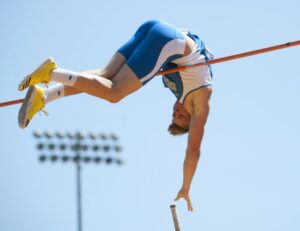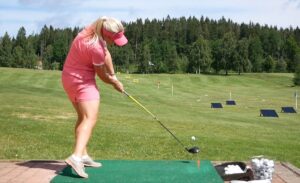A lot has been written lately on the center of pressure (CoP), center of mass (CoM) and their effects on increasing clubhead speed.
The center of pressure, simply, is the point on the ground where the sum of all forces exerted by the body lies. If we were to stand normally, the left and right foot would drive a force into the ground about equally. The center of pressure in this case would be halfway in between each foot.
We could alter the center of pressure simply by lifting one foot off the ground. This would cause the other foot to temporarily be the exact center of pressure, as it is the only contact point with the ground.
The center of mass would be the exact middle, by weight, of our body. In a normal standing position, this point is just below the navel in most people.
We could alter the center of mass if we simply squatted down, like a baseball catcher. The center of mass would drop downward, but since we are still balancing equally on both feet, the center of pressure wouldn’t have to change.
We can position our body in such a way that the center of mass is actually outside our physical body, as demonstrated by an expert pole vaulter:

In this contorted position, the vaulter’s center of mass is probably between his knees and his chest. It is actually below the bar at this point, and thus demonstrates the advantage of this position to achieve greater heights.
The center of pressure not only has a mean point on the ground, but also a magnitude. The amount of force we generate into the ground can be much greater than our actual body weight.

5 time world long drive champion Sandra Carlborg has been measured exerting 210% of her bodyweight into the ground via her front foot only. According to Sasho McKenzie, PhD. in Biomechanics, it is common to see an excess of 200% bodyweight transferred into the ground in longer hitters as they move towards impact.
This bring us to the Happy Gilmore swing. Remember Happy could run up into the ball and hit it over 400 yards. This swing has actually been studied a bit:
So in Harrington’s case he picked up 7 mph and over 20 yards of distance with the Happy Gilmore approach. Although some of the gains in speed is from the lateral speed of 4 mph, he is probably picking up added torque and therefore clubhead speed from the increased force applied to the ground by his left foot.
Harrington states that he would not necessarily employ this technique is competition because of the lack of accuracy.
A modified Happy Gilmore style swing was employed by Connor Powers, a 2014 world long drive finalist, with some success. He recorded the highest measured swing speed in the history of long drive competition at 156 mph. However, his technique ultimately proved too inaccurate and imprecise.
In Powers case, this swing style immediately netted more clubhead speed. He abandoned the approach in successive years, and his speed subsequently dropped.
The ultimate balance between the Happy Gilmore style, which clearly creates tremendous clubhead speed, but retaining the ability to strike the ball precisely and accurately is the Mike Austin style of swing, in my opinion.
The highlights are the aggressive lateral shift of the hips off the ball in the backswing and the raising up of the front heel, under a relatively steady head. Only the inside of the left big toe would touch the ground at the top of the swing. Mike often called this the ‘classic swing’, or a technique widely used by professional golfers before around 1980.

Mike was reportedly measured or estimated swinging at or over 150 mph, with a 43.5″ persimmon driver.
Austin’s backswing could be termed a ‘mini run up’ a la Happy Gilmore, and therefore gains some of the lateral run up speed of the Harrington speed (CoG shift), combined with an increase in center of pressure measurements exerted by the left foot planting in the downswing (CoP) How much speed he gained from this is unclear.
At the same time, with the more steady head and balance, Austin would not lose the ability to precisely strike the golf ball. This was evidenced by his irons sets displaying wear marks the size of a dime in the middle of the clubface.
So is Mike Austin’s swing technique the best of both worlds? The most powerful swing without sacrificing accuracy?
